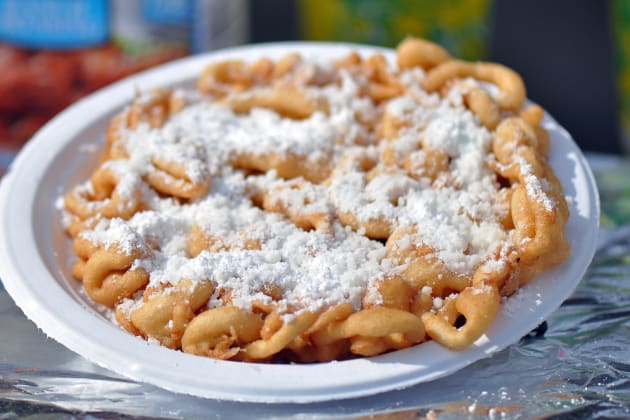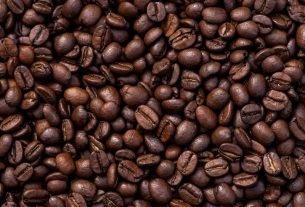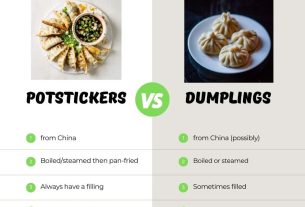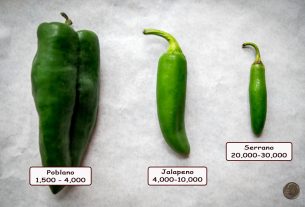Step right up and indulge in a sugary delight that will transport your taste buds to the exhilarating world of fairs and carnivals.
Prepare for a battle of textures and flavors as we explore the showdown between two beloved treats: the luscious funnel cake and the tantalizing elephant ear.
With their distinctive appearances, unique ingredients, and a fan base that spans the globe, these scrumptious delights will leave you yearning for more.
Let’s dive into the delicious details and find out which treat reigns supreme in the kingdom of fair food.
funnel cake vs elephant ear
The main differences between funnel cakes and elephant ears lie in their appearance, ingredients, and regional popularity.
Funnel cakes have a lacy, pretzel-like appearance with overlapping pieces, while elephant ears are a single, bubble-filled blob.
Funnel cakes are made from a pancake or waffle batter, while elephant ears are made from sweet pastry dough.
Additionally, elephant ears are more commonly found in the Midwest, while funnel cakes are more widespread.
Ultimately, both treats are popular fair foods and have their own unique toppings, with powdered sugar commonly used for funnel cakes and cinnamon and sugar for elephant ears.
Key Points:
- Funnel cakes have a lacy, pretzel-like appearance while elephant ears are a single, bubble-filled blob.
- Funnel cakes are made from pancake or waffle batter, while elephant ears are made from sweet pastry dough.
- Elephant ears are more commonly found in the Midwest, while funnel cakes are more widespread.
- Both treats are popular fair foods and have their own unique toppings.
- Powdered sugar is commonly used for funnel cakes while cinnamon and sugar is used for elephant ears.
- The main differences between funnel cakes and elephant ears lie in their appearance, ingredients, and regional popularity.
funnel cake vs elephant ear – Watch Video
💡
Pro Tips:
1. Funnel cakes were originally introduced in Pennsylvania Dutch Country during the late 19th century and were traditionally made by pouring batter through a funnel into hot oil, creating the characteristic shape and texture.
2. Elephant ears, also known as beaver tails, are a popular Canadian treat often sold at fairs and outdoor festivals. Contrary to their name, they are not made from elephant ears but are rather fried pieces of dough sprinkled with cinnamon and sugar.
3. Funnel cakes are believed to have originated from a German dish known as “Striezel,” which is similar in preparation but usually baked instead of fried. The German immigrants later adapted the recipe to create funnel cakes as we know them today.
4. In some regions, elephant ears can be topped with various sweet or savory toppings, including Nutella, powdered sugar, whipped cream, cinnamon, or even chili and cheese. Each region has its own unique take on this tasty treat.
5. Funnel cakes have a distinct spiral pattern due to the way the batter is poured into the oil. The batter is swirled in a circular motion, creating a unique shape that allows for even cooking and a perfect combination of crispy and soft textures.
Introduction: Funnel Cake Vs Elephant Ear – Carnival Sweet Treats
Carnivals and fairs are known for their delectable food options, and two beloved treats that are always present are funnel cakes and elephant ears. These fried delicacies provide a delightful burst of sweetness that enhances the carnival experience. Although they share common traits, such as being fried to golden perfection and dusted with powdered sugar, there are notable differences between funnel cakes and elephant ears. Let’s delve into their dissimilarities, ranging from appearance to ingredients and preparation.
-
Appearance: Funnel cakes have a distinctive latticework pattern, resembling fried dough poured through a funnel to create a web-like appearance. On the other hand, elephant ears are flat, circular pastries that resemble the shape of an elephant’s ear (hence the name).
-
Ingredients: Funnel cakes are typically made from a simple batter mixture consisting of flour, milk, eggs, and sugar. In contrast, elephant ears are made from a yeast-based dough, which gives them a slightly different texture compared to funnel cakes.
-
Preparation: Funnel cakes are made by pouring the batter through a funnel into hot oil, creating a spiral pattern that crisps up into a delicious, golden brown treat. Elephant ears, on the other hand, are made by rolling out the dough until it is thin and then frying it until it puffs up and becomes crispy.
In summary, both funnel cakes and elephant ears are delightful carnival treats that offer a sugary indulgence. However, their differences in appearance, ingredients, and preparation make each one unique.
Distinctive Appearance: Lacy Funnel Cakes Vs Bubble-Filled Elephant Ears
One of the first things that catch the eye when comparing funnel cakes and elephant ears is their distinctive appearance.
Funnel cakes have a lacy, pretzel-like design with overlapping pieces that give them an intricate and visually appealing look. When prepared, the batter is poured through a funnel in a circular pattern, creating a delicate web of fried goodness.
On the other hand, elephant ears have a simpler appearance, resembling a single, bubble-filled blob. The dough is stretched and stretched until it forms a thin and elongated shape resembling an elephant’s ear, hence the name.
While both treats are fried to a crispy perfection, their differing appearances give them a unique charm that adds to their allure.
Differences In Ingredients And Preparation
The differences between funnel cakes and elephant ears also extend to their ingredients and preparations. Funnel cakes are typically made from a pancake or waffle batter. This batter is a simple mixture of flour, sugar, milk, and eggs, creating a smooth and pourable consistency that forms the characteristic lacy pattern when fried. Elephant ears, on the other hand, are made from sweet pastry dough. The dough is prepared by combining flour, sugar, yeast, and butter or oil, resulting in a richer and denser texture. This dough is rolled out thinly, stretched, and then deep-fried until it reaches a golden brown color. The distinct recipes of these treats contribute to their contrasting taste and texture profiles.
Popularity: Elephant Ears And Funnel Cakes At Fairs
Elephant ears and funnel cakes have become synonymous with fair and carnival culture. These sweet treats are beloved by people of all ages, as they satisfy the craving for something decadent and indulgent. While both treats can be found at carnivals and fairs across the country, their popularity may vary depending on the region.
-
Elephant ears, for example, are more commonly found in the Midwest, where they have become a staple treat at many state fairs.
-
Funnel cakes, on the other hand, are more widespread and can be enjoyed at various fairs throughout the nation.
Regardless of their regional popularity, both treats hold a special place in the hearts of fairgoers everywhere.
Regional Variation: Elephant Ears In The Midwest, Funnel Cakes Everywhere
Elephant ears and funnel cakes have distinct regional variations in popularity. Elephant ears have particularly strong ties to the Midwest, where they have become a beloved fair food. The Midwest region is known for its agricultural heritage and rich culinary traditions, making it the perfect setting for these doughy delights.
On the other hand, funnel cakes have a more extensive reach and can be found in various fairs across the country. Whether you’re in the heartland of the Midwest or on the East or West Coast, you’re likely to encounter the tantalizing aroma of funnel cakes wafting through the air at a carnival or fair.
Funnel Cake Batter Vs Sweet Pastry Dough
The ingredients used in funnel cakes and elephant ears greatly contribute to their distinct flavors and textures.
-
Funnel cakes are made from a batter typically used for pancakes or waffles. This batter consists of flour, sugar, milk, eggs, and sometimes baking powder.
- The result is a light and crispy outer layer with a fluffy interior, providing a delightful contrast in each bite.
-
In contrast, elephant ears are made from a sweet pastry dough. This dough incorporates flour, sugar, yeast, and butter or oil, resulting in a doughy and slightly denser texture.
- The dough is stretched and fried, creating a delightfully chewy experience with a satisfying crunch.
Both the batter of funnel cakes and the dough of elephant ears contribute to the unique eating experience of these carnival favorites.
-
- Funnel cakes are made from a batter consisting of flour, sugar, milk, eggs, and sometimes baking powder.
-
- Elephant ears are made from a sweet pastry dough incorporating flour, sugar, yeast, and butter or oil.
-
- Funnel cakes have a light and crispy outer layer with a fluffy interior.
-
- Elephant ears have a doughy and slightly denser texture.
-
- Funnel cakes provide a delightful contrast in each bite.
-
- Elephant ears create a delightfully chewy experience with a satisfying crunch.
Both funnel cakes and elephant ears are carnival favorites that offer a unique and enjoyable eating experience.
- Elephant ears create a delightfully chewy experience with a satisfying crunch.
Toppings: Cinnamon And Sugar For Elephant Ears, Powdered Sugar For Funnel Cakes
While both funnel cakes and elephant ears are dusted with powdered sugar, they often have different traditional toppings. Elephant ears are traditionally sprinkled with a generous amount of cinnamon and sugar. The warmth of cinnamon combined with the sweetness of sugar creates a heavenly aroma and flavor that perfectly complements the doughy base. On the other hand, funnel cakes are typically topped with a liberal dusting of powdered sugar. The powdery sweetness enhances the delicate flavor of the funnel cake, providing a satisfyingly sweet experience. Both these toppings are classics and play a vital role in elevating the overall taste of these carnival treats.
Elephant Ears Absent At County Fair Chicago
While everyone eagerly anticipates attending the County Fair Chicago event, it is important to note that elephant ears will not be on the menu this year. However, fear not, for there will be plenty of other mouthwatering treats to enjoy. Bo’s Concessions, a prominent vendor at the fair, will be serving a variety of delicious foods, including:
- Corn dogs
- Funnel cakes
- Lemon shake-ups
- Cotton candy
While the absence of elephant ears may disappoint some, the diverse range of other delectable options promises to make this fair experience a memorable one.
Other Fair Treats: Corn Dogs, Lemon Shake-Ups, Cotton Candy Served By Bo’S Concessions
In addition to funnel cakes, Bo’s Concessions equally tantalizes fair-goers with their offering of other classic fair treats. One such delicacy is the ever-popular corn dog. This quintessential fair food consists of a hot dog on a stick, dipped in cornmeal batter, and deep-fried to a golden brown. The result is a crispy outer layer that encases a juicy, flavorful hot dog.
Another refreshing treat that Bo’s Concessions serves is the lemon shake-up. This thirst-quenching beverage combines freshly squeezed lemons, sugar, and ice, resulting in a tangy and invigorating drink perfect for those hot fair days.
And of course, no fair experience would be complete without cotton candy. The fluffy clouds of spun sugar come in vibrant colors and melt in your mouth, leaving behind a sugary sweetness that brings pure joy.
These irresistible fair treats, in addition to the classic funnel cakes, ensure a truly enjoyable fair experience for attendees.
Bullet points:
- Corn dogs
- Lemon shake-up
- Cotton candy
Conclusion: Enjoying The Diverse Flavors Of Carnival Sweets
Carnival sweets such as funnel cakes and elephant ears have a special place in the hearts of fair-goers. With their distinctive appearances and regional popularity, these treats bring joy and excitement to every carnival or fair experience. Whether you prefer the lacy, overlapping pieces of a funnel cake or the bubble-filled, elongated shape of an elephant ear, both treats offer a delightful combination of flavors and textures. So, the next time you find yourself at a fair or carnival, be sure to indulge in these fried delicacies and revel in the diverse flavors of carnival sweets.
💡
You may need to know these questions about funnel cake vs elephant ear
What’s the difference between elephant ears and fried dough?
Fried dough, also referred to as funnel cake, is a delicious treat made by pouring a batter of flour, sugar, and milk into hot oil. Once fried, it is dusted with powdered sugar or sometimes drizzled with chocolate or other toppings. Although similar in the sense that both treats are made from fried dough, elephant ears differ from fried dough in terms of texture and shape. Elephant ears have a crispy, flaky texture and are usually larger and thinner compared to the thicker, cake-like consistency of fried dough. While fried dough often takes the form of spirals or puffy balls, elephant ears are specifically shaped like uneven, wrinkled circles that resemble, as their name suggests, an elephant’s ear.
What is the difference between jumbo ears and funnel cakes?
The main difference between jumbo ears and funnel cakes lies in their texture and structure. Funnel cakes have a distinct lacy pattern, resembling a pretzel, with overlapping and interconnected pieces that create a unique, intricate design. On the other hand, jumbo ears lack this detailed pattern and appear as a single, solid mass with large air pockets or bubbles. While both may have a disc-like shape, the visual variance in their structure sets them apart, making each treat visually distinctive and appealing in its own way.
What is an elephant ear?
An elephant ear refers to a collection of exotic, perennial plants cultivated primarily for their remarkable, heart-shaped foliage. These tropical plants, aptly named due to their resemblance to the ears of an elephant, feature vibrant green leaves that can grow to impressive sizes. Renowned for their grandeur and unique appearance, elephant ears add a touch of boldness and lushness to gardens and landscapes, making them a popular choice among plant enthusiasts and horticulturists alike. With their distinct leaf structure, these plants exhibit both elegance and intrigue, bringing an exotic charm to any botanical collection.
What is elephant ears food Midwest?
In the Midwest, elephant ears are often enjoyed as a delectable fair treat. A unique twist on the traditional recipe includes topping the fried dough with a generous dollop of creamy vanilla ice cream and drizzling it with warm caramel sauce for an indulgent dessert experience. This delightful combination of crispy dough, rich butter, and sweet toppings is sure to satisfy any sweet tooth in the heartland.
Reference source
https://www.chicagotribune.com/dining/craving/ct-food-county-fair-foods-20180809-story.html
https://www.thegunnysack.com/elephant-ears-recipe/
https://www.mashed.com/1360520/difference-between-funnel-cakes-elephant-ears/
https://hort.extension.wisc.edu/articles/elephant-ears-colocasia-alocasia-and-xanthosoma/



